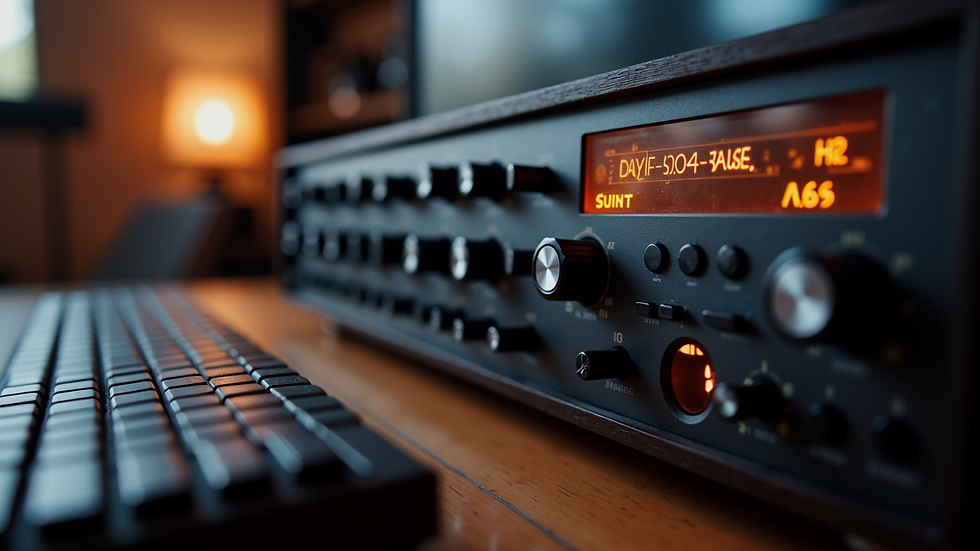Understanding Digital Amp Modeling for Musicians
- DR Prophecy
- Sep 29
- 4 min read
Hey there, tone chasers and sonic sorcerers! Ready to dive headfirst into the wild, wired world of digital amp modeling? Buckle up, because we’re about to blast through the basics, bust some myths, and boost your sound game with some seriously slick digital amp modeling techniques. Whether you’re shredding on guitar, thumping on bass, or crafting beats in your studio, this is your backstage pass to the future of tone.
What the Heck is Digital Amp Modeling Anyway?
Let’s cut the fluff. Digital amp modeling is the art and science of mimicking classic and modern guitar and bass amplifiers using software or hardware. Instead of lugging around a monstrous stack of amps, you get a pocket-sized powerhouse that can sound like any amp you want.
Think of it as a chameleon for your rig. You plug in, select your amp model, tweak the settings, and boom - you’re rocking the vibe of a vintage Marshall, a crunchy Fender, or a screaming Mesa Boogie. All without the sweat, the weight, or the noise complaints.
Why Should You Care?
Portability: Gigging? Practice? Studio session? Your entire amp collection fits in your backpack.
Versatility: One device, endless tones. Dial in clean jazz, dirty blues, or face-melting metal in seconds.
Cost-effective: No need to buy dozens of amps. One modeler can cover them all.
Consistency: Get the same killer tone every time, no matter where you play.

Digital amp modelers pack a universe of tones into a compact device.
Digital Amp Modeling Techniques You Need to Know
Alright, now that you’re hooked, let’s get tactical. Here are some killer digital amp modeling techniques to sharpen your sound and your skills.
1. Profile Your Own Amps
Why settle for presets when you can create your own? Profiling is the process of capturing the exact sound of your favourite amp and cabinet. Using devices like the Kemper Profiling Amp, you can record the nuances of your rig and save it as a digital profile.
Pro tip: Experiment with mic placement during profiling. Move the mic closer, farther, or off-axis to capture different tonal flavours. This is where the magic happens.
2. Layer Your Sounds
Don’t just stick to one amp model. Stack multiple models or blend amp sims with effects to create a unique sonic signature. For example, combine a warm tube amp model with a crunchy overdrive pedal simulation for a thick, textured tone.
Try this: Use a clean amp model as your base and layer a distorted amp on a separate channel. Mix and match until you find that sweet spot.
3. Use Impulse Responses (IRs)
Impulse Responses are digital snapshots of speaker cabinets and mic setups. They add realism and depth to your amp models. Many modelers allow you to load custom IRs, so you can tailor your sound even further.
Action step: Download free or paid IR packs online and swap them out to hear how different cabinets and rooms affect your tone.

Impulse responses capture the essence of speaker cabinets for authentic tone.
4. Tweak Your EQ Like a Pro
Digital amp modeling gives you precise control over your EQ settings. Don’t just rely on presets. Dive into the bass, mid, and treble controls to sculpt your sound. Remember, small tweaks can make a huge difference.
Quick tip: Cut frequencies that clash with your bandmates’ instruments to carve out your own sonic space.
5. Experiment with Effects Integration
Most digital amp modelers come loaded with effects - from reverb and delay to modulation and compression. Use these effects creatively to enhance your tone without muddying it.
Try layering: A subtle delay with a touch of reverb can add space and dimension to your playing. Or crank up the chorus for a shimmering, dreamy vibe.
The Gear That Makes It Happen
You’re probably wondering what gear you need to jump into digital amp modeling. Here’s a quick rundown of the essentials:
Modeling Amplifiers: Kemper Profiling Amp, Line 6 Helix, Fractal Axe-Fx, Boss GT series.
Software Plugins: Neural DSP, Amplitube, Guitar Rig, Bias FX.
Audio Interface: For connecting your guitar to your computer or DAW.
Impulse Response Libraries: To load into your modeler or plugin.
MIDI Controllers: For hands-free switching during live gigs.
If you want to explore high-quality Kemper Profiles and Tonex Captures, check out drprophecystudio. They’re constantly expanding their library to help you nail that perfect tone.

Amp modeling software opens a world of tonal possibilities right on your computer.
How to Nail Your Tone Every Time
Getting a killer tone isn’t just about gear - it’s about technique and mindset. Here’s how to make your digital amp modeling sing:
Start with a great guitar: Your tone begins at the source. Invest in a guitar that feels and sounds good to you.
Use quality cables and interfaces: Don’t skimp here. Clean signal paths preserve your tone.
Learn your modeler inside out: Spend time exploring every knob, switch, and menu.
Save your presets: Once you find a sound you love, save it. You’ll thank yourself later.
Record and listen back: Sometimes your ears hear things differently live. Recording helps you fine-tune your tone.
Ready to Rock Your Digital Rig?
Digital amp modeling is not just a trend - it’s a revolution. It’s about freedom, flexibility, and fierce creativity. Whether you’re a bedroom warrior or a stage beast, mastering these digital amp modeling techniques will unlock new dimensions in your playing.
So, grab your guitar, fire up your modeler, and start experimenting. Your perfect tone is just a few clicks away. And remember, the tone quest never ends - keep pushing, keep tweaking, and keep rocking.
For more killer profiles and tips, swing by drprophecystudio and join the tone tribe.
Rock on, rebel!



Comments